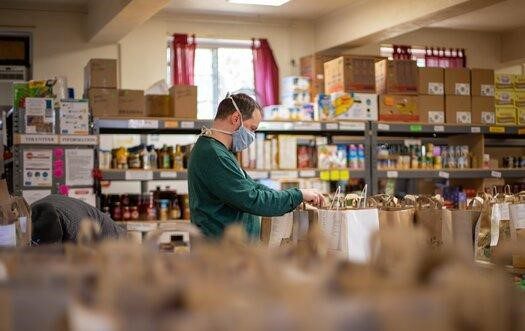By Megan Ng
In a recent White House conference, the topics of hunger, nutrition, and health were discussed. Some of the country’s top nutrition and food challenges include the increase in diet-related disease, food insecurity, and increasing gaps in health access.
Important statistics from the conference(Task Force on Hunger, Nutrition, and Health, 2022):
● One in 10 U.S. households was food insecure at least some time during 2020.
● Only one in 15 U.S. adults has good cardiometabolic health.
● One in four children has prediabetes and is overweight or obese.
The statistics above show that families with racial and ethnic minorities, from lower economic classes, and living in rural areas are more likely to be affected. Poor access to food and nutrition can affect productivity, health care spending, and military readiness (Task Force on Hunger, Nutrition, and Health, 2022).
Introduction to SNAP and EFNEP
Policy recommendations include improving nutrition education and access to federal nutrition programs. One of the largest programs working to fight food insecurity and hunger in America is called the Supplemental Nutrition Assistance Program (SNAP), formerly called food stamps.
SNAP allows families to receive monthly funds through a benefits card, similar to a debit card, to buy groceries at local stores or farmers’ markets (Supplemental Nutrition Assistance Program (SNAP), n.d.). The amount you receive each month depends on your income and family size. SNAP is not just for families. Seniors, people living with disabilities, people who are unemployed or employed, and veterans or active military can apply (What is SNAP and How to Apply, n.d.).
The SNAP program works closely with the Expanded Food and Nutrition Education Program (EFNEP). This nutrition education program is for low-income and low-resource families to receive interactive workshops and lessons for improving physical activity, food safety, and other health behaviors. EFNEP is provided by the Cooperative Extension Service in each state (Expanded Food and Nutrition Education Program (EFNEP), n.d.).
SNAP and EFNEP Eligibility
Every state has different requirements for eligibility. These requirements might include: (What is SNAP and How to Apply, n.d.)
● Household income must be at or below a certain level
● Household resources or assets, such as savings and bank accounts, must be less than a certain amount
● At least one U.S. citizen or person with an eligible immigration status must live in the household
Check with your local SNAP office or your local food bank for help understanding if you are eligible.
If you are eligible for SNAP and other assistance programs, you are likely also eligible for EFNEP. Check with your local Cooperative Extension Service to make sure.
What Can I Buy With SNAP?
You can buy: (What is SNAP and How to Apply, n.d.)
● Fruits and vegetables
● Meat, fish, and poultry
● Dairy products
● Bread and cereals
● Snacks and beverages
● Seeds and plants to grow food for your family
You cannot buy: (What is SNAP and How to Apply, n.d.)
● Alcohol or tobacco products
● Non-food items (pet food, cleaning supplies, household supplies like toilet paper, or hygiene items like shampoo, menstrual products, baby formula, or diapers)
● Vitamins and medicines
Summary
Hunger, nutrition, and food security play an important role in the health of your family. However, the issues surrounding hunger, nutrition, and food security are difficult to solve. With the help and understanding of SNAP and EFNEP, resources for living a healthier life are more accessible for low-income and low-resource families.
For more resources, check out these links below:
● For more information on what SNAP is about, visit Feeding America
● For SNAP eligibility, updates, and resources, visit the Food and Nutrition Service Department within the U.S. Department of Agriculture
● To find the website associated with your local Cooperative Extension Service, take a look at the EFNEP partner websites from the U.S. Department of Agriculture
References
- Expanded Food and Nutrition Education Program (EFNEP). National Institute of Food and Agriculture U.S. Department of Agriculture. Retrieved 31 August 2022, from https://www.nifa.usda.gov/grants/programs/capacity-grants/expanded-food-nutrition-education-program-efnep.
- Supplemental Nutrition Assistance Program (SNAP). Food and Nutrition Service U.S. Department of Agriculture. Retrieved 31 August 2022, from https://www.fns.usda.gov/snap/supplemental-nutrition-assistance-program.
- Task Force on Hunger, Nutrition, and Health. (2022). Ambitious, Actionable Recommendations to End Hunger, Advance Nutrition, and Improve Health in the United States. Chicago Council on Global Affairs, Food Systems for the Future, the Gerald J. and Dorothy R. Friedman School of Nutrition Science and Policy at Tufts University, and World Central Kitchen. 2022 Task Force Report | Informing the White House Conference (informingwhc.org)
- What is SNAP and How to Apply? Feeding America. Retrieved 31 August 2022, from https://www.feedingamerica.org/our-work/hunger-relief-programs/snap.
Megan Ng is a Graduate Student of Food Science and Human Nutrition at the University of Illinois at Urbana Champaign
Image by Aaron Doucett from Unsplash













